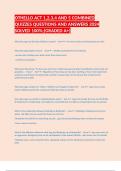Examen
A&P 2 Digestion Exam Study Guide Questions with 100% Verified Correct Answers
- Cours
- Établissement
A&P 2 Digestion Exam Study Guide Questions with 100% Verified Correct Answers what are the 4 functions of the digestive system? - Correct Answer - ingestion - digestion - absorption - defecation what 2 things occur during digestion? - Correct Answer - breakdown of food into simple molecules ...
[Montrer plus]












